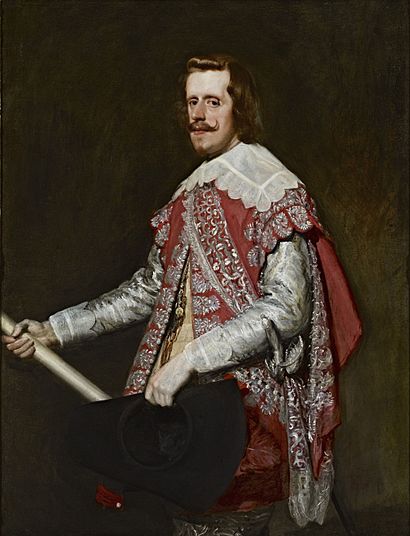Portrait of Philip IV in Fraga facts for kids
Quick facts for kids Portrait of Philip IV in Fraga |
|
|---|---|
| Spanish: Felipe IV en Fraga | |
 |
|
| Artist | Diego Velázquez |
| Year | 1644 |
| Medium | Oil on canvas |
| Dimensions | 129.8 cm × 99.4 cm (51.1 in × 39.1 in) |
| Location | Frick Collection, New York City |
The Portrait of Philip IV in Fraga is a famous painting of Philip IV of Spain by the Spanish artist Velázquez. Velázquez painted this portrait in June 1644. He worked on it during three different times in the town of Fraga.
King Philip IV had moved his royal court to Fraga. This was part of a military trip called the "Jornada de Aragón." During this trip, Spain took back the city of Lérida from France. France had taken Lérida during a conflict known as the Reapers' War.
Later, in 1748, King Philip V gave this painting to his son, who would become Philip, Duke of Parma. This is how the painting left Spain. In 1911, the Frick Collection in New York City bought the painting. You can see it there today.
Contents
A Lifelike Portrait
Many people thought this painting looked very real. An art historian named Antonio Palomino wrote about it. He said Velázquez painted the king "in the way he entered Lérida." The king was holding a military staff, which is like a special stick for leaders. He was wearing a fancy red velvet suit. Palomino said the painting had "such a beautiful air, so much grace, and majesty." He felt the painting looked like "another living Philip."
How the Painting Was Made
We know a lot about how this portrait was created. Records show the costs for making it. For example, money was spent to build two new windows in the throne room. This was where the king posed for Velázquez. Money was also used to fix up the room Velázquez used as his art studio. It had been in bad condition.
At the same time, Velázquez was also painting another portrait. This was of a court dwarf named Diego de Acedo, also known as El Primo. That painting was sent to Madrid in June 1644. It seems to be different from the painting of the dwarf that is now in the Prado Museum.
Public Display
The painting of King Philip IV was finished by the end of June. It was then sent to the king's wife, Queen Elisabeth. She wanted the public to see it. A writer named José Pellicer noted that on August 16, 1644, the painting was shown in a church. It was displayed "under a canopy embroidered with gold." A canopy is a decorative cover, often used for important people. Many people came to see the painting, and copies were made of it.
Inspiration and Copies
Some art experts believe Velázquez might have been inspired by another painting. This was Cardinal-Infante Ferdinand of Austria by Anthony van Dyck. That painting had been in Madrid since 1636.
There are several copies of the Portrait of Philip IV in Fraga. One of the most well-known copies is at the Dulwich Picture Gallery in London. For a while, people thought this copy was the original painting by Velázquez. However, in 1911, an expert named Aureliano de Beruete said it was actually painted by Juan Bautista Martínez del Mazo. This helped art experts realize that the painting in New York was the true original.
See also
 In Spanish: Felipe IV en Fraga para niños
In Spanish: Felipe IV en Fraga para niños
- List of works by Diego Velázquez

